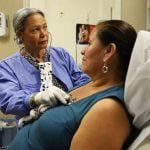

Bodybuilding Keratosis pilaris (KP), also known as “keratosis follicularis,” is a common skin condition that affects the skin of the trunk, arms and legs. Bodybuilders and athletes are especially susceptible to KP because sweat and sebum can exacerbate the symptoms. Here’s what you need to know about KP and how to treat it:
Bodybuilding is one of the most physically demanding sports out there. As such, it can lead to keratosis pilaris, or KP, a skin disorder that causes small bumps on the skin. Keratosis pilaris is a common skin disorder that affects the skin of the trunk, arms and legs. Bodybuilders and athletes are especially susceptible to KP because sweat and sebum can exacerbate the symptoms. Here’s what you need to know about KP and how to treat it:
There are many treatments for KP; however, some people find success with topical creams or ointments. Treatment typically starts with a mild cleanser followed by a moisturizer that contains SPF protection. If topical treatments aren’t successful, doctors may prescribe oral medication or surgery to remove the bumps.
Contents
- 1 What is Bodybuilding Keratosis Pilaris?
- 2 Causes and Treatment of Bodybuilding Keratosis Pilaris
- 3 How to Prevent BKP:
- 4 What is bodybuilding keratosis pilaris?
- 5 How bodybuilding keratosis pilaris affects bodybuilders
- 6 Treatment for BKP
- 7 Prevention of bodybuilding keratosis pilaris
- 8 What is Bodybuilding Keratosis Pilaris?
- 9 Causes and Risk Factors for Bodybuilding Keratosis Pilaris
- 10 Treatment Options for Bodybuilding Keratosis Pilaris
- 11 What is bodybuilding keratosis pilaris?
- 12 How bodybuilding keratosis pilaris affects bodybuilders
- 13 Treatment for bodybuilding keratosis pilaris
- 14 What is bodybuilding keratosis pilaris?
- 15 Causes of bodybuilding keratosis pilaris
- 16 Treatment methods for bodybuilding keratosis pilaris
- 17 What is Bodybuilding Keratosis Pilaris?
- 18 Types of BKP
- 19 How to Treat BKP
- 20 Prevention Tips for BKP
- 21 Conclusion
What is Bodybuilding Keratosis Pilaris?
Bodybuilding keratosis pilaris is a skin condition that affects bodybuilders and other athletes who are regularly in the sun or participating in intense physical activity. It is a benign skin tumor that can develop on the backs of the hands, arms, legs, neck or face.
Keratosis pilaris is caused by an overgrowth of keratinocytes (the cells that make up the skin). Keratosis pilaris usually appears as small bumps on the skin that may become raised and scaly. The bumps may also be red, irritated and itchy.
There is no known cure for keratosis pilaris, but treatment typically includes topical treatments such as steroids, moisturizers and antibiotics. Some people elect to have surgery to remove the bumps.
If you are experiencing any symptoms of keratosis pilaris, please consult your doctor.
Causes and Treatment of Bodybuilding Keratosis Pilaris
Bodybuilding keratosis pilaris is a skin condition that is common in bodybuilders and other athletes. It is a benign skin tumor that tends to form on the back of the hand and the lower arm. The cause of keratosis pilaris is unknown, but it may be related to excessive sun exposure or steroid use.
There is no known cure for keratosis pilaris, but treatment includes topical creams and antibiotics. The tumor can be removed surgically if it becomes large or bothersome.
How to Prevent BKP:
Bodybuilding keratosis pilaris (BKP) is a skin condition that’s caused by excessive sweating, oil accumulation and inflammation. BKP can be a major hindrance to bodybuilders who want to achieve their muscular physique. However, there are ways to prevent and treat BKP. Here are four tips:
1. Use a humidifier in your home or office to keep your skin hydrated.
2. Reduce the amount of oil you use on your body. This includes using a moisturizer and using natural oils such as grapeseed oil, coconut oil or olive oil instead of synthetic fragrances or oils.
3. Use an antiperspirant medication that contains aluminum chloride to help reduce sweat production and the formation of BKP. Aluminum chloride is found in many over-the-counter antiperspirants including SCOTCH-BRITE® Antiperspirant Deodorant, Right Guard®, Secret® No Odor Antiperspirant/Deodorant and Wet Ones® Antiperspirant Stick, among others.
4. Seek medical assistance if your skin becomes severely inflamed or if you experience large amounts of pus discharge from the
What is bodybuilding keratosis pilaris?
Keratosis pilaris, or bodybuilding keratosis, is a skin condition that occurs primarily in people who are physically active and have a lot of sun exposure. It is a benign condition that affects the epidermis (the outer layer of the skin) and can lead to the development of keratin clumps on the skin.
There is no known cure for bodybuilding keratosis pilaris, but it can be treated with topical medications and/or surgery. In most cases, keratosis pilaris clears up on its own within 6-12 months after onset.
If you are concerned about your skin and would like to learn more about keratosis pilaris, please click here to read our full article.
How bodybuilding keratosis pilaris affects bodybuilders
Bodybuilding keratosis pilaris is an uncommon skin condition that affects bodybuilders. Here is a look at what keratosis pilaris is, how it affects bodybuilders, and treatments for the condition.
Bodybuilding keratosis pilaris (BKP) is an uncommon skin condition that affects men and women who participate in physical activity, such as bodybuilding.
Treatment for BKP
Keratosis pilaris is a skin condition that affects bodybuilders and other people who engage in physical activity. It’s a type of acne, but it’s more common on the face and chest. Keratosis pilaris usually clears up on its own in about six to 12 months, but there are treatments available if it doesn’t go away.
One treatment option is topical steroids. These creams or injections help shrink the keratosis pilaris lesions and reduce inflammation. They also cause the skin to become denser, which reduces the appearance of bumps. Side effects of topical steroids include increased hair growth and skin irritation.
If topical steroids aren’t effective, other treatments include light therapy (used for photodamage), cryotherapy (used for icepick scars), or laser therapy (used for superficial lesions). Each has its own benefits and drawbacks, so it’s important to choose the treatment that’s right for you.
Prevention of bodybuilding keratosis pilaris
Bodybuilders are more prone to developing keratosis pilaris, also known as KP, because of the increased exposure to the sun and sweat.
KP is a skin condition that manifests as small, hard bumps on the skin that can be very itchy. It is common in people who work out intensely and are exposed to the sun.
There are several things you can do to prevent KP from developing: avoid overexposure to the sun, use sunscreen every day, wear hats and sunglasses when outside, and stay hydrated.
If you do develop KP, there are a few treatments available. You can apply topical corticosteroids or azelaic acid cream to the bumps. If this does not work, your doctor may recommend laser therapy or cryotherapy for more severe cases of KP.

What is Bodybuilding Keratosis Pilaris?
Bodybuilding Keratosis Pilaris is a skin condition that affects bodybuilders and other athletes. It’s also known as “keratosis pilaris benigna,” “ KPB,” or simply “keratosis pilaris.”
KPB is a skin disorder characterized by the development of bumps on the skin, most commonly on the chest and back. The bumps are usually small and red, but they can grow to be quite large and cause significant discomfort.
Most people with KPB don’t experience any symptoms at all; however, a small percentage of people develop mild to moderate symptoms that can interfere with their day-to-day activities.
The most common symptom is pain when the bumps are touched or moved, but other symptoms may include:
- redness
- tenderness
- swelling
- sensitivity to sunlight
- difficulty breathing
KPB is caused by an overgrowth of keratinocytes (cells that make up the outer layer of the skin). This overgrowth results in the formation of small bumps on the skin. Most people with KPB have no symptoms at all
Causes and Risk Factors for Bodybuilding Keratosis Pilaris
Bodybuilding often results in the development of keratosis pilaris, a benign skin disorder that typically appears on the chest and back. Keratosis pilaris is caused by an overgrowth of keratinocytes, the cells that make up the skin’s outer layer. There is no one definitive cause for keratosis pilaris, but there are a number of risk factors that may increase your chances of developing the disorder.
Some of the most common risk factors for keratosis pilaris include:
-A history of skin cancer
-Excessive sun exposure
-Having a family history of skin cancer
– Having a sensitive skin type
-Being heavily into bodybuilding or weightlifting
-Having a Mediterranean or Mediterranean/Caucasian heritage
-Having brown or black skin color
-Being over 50 years old
There is no cure for bodybuilding keratosis pilaris, but there are treatments that can help relieve the symptoms. Some common treatments include topical creams and ointments, oral medications, and laser therapy. If you are concerned about your own risk for bodybuilding keratosis p
Treatment Options for Bodybuilding Keratosis Pilaris
If you are a bodybuilder and have keratosis pilaris, there are several treatment options available to you. Some people choose to live with the disorder and accept its limitations, while others seek out treatments that can help them improve their appearance. Here are some of the most common treatments for keratosis pilaris:
topical creams and lotions
topical prescription medications
cryotherapy (using a cryogenic machine to freeze the skin)
laser therapy (using a laser to burn away thekeratosis pilaris)
surgical removal (surgical procedure to remove the keratosis pilaris)
Each treatment option has its own benefits and disadvantages. It is important to discuss your options with a qualified doctor before making a decision.
What is bodybuilding keratosis pilaris?
Bodybuilding keratosis pilaris is a skin condition that affects bodybuilders. It’s also known as benign keratosis pilaris, and it’s a type of psoriasis. Bodybuilders are at an increased risk for developing keratosis pilaris because they put a lot of pressure on their skin while working out.
keratosis pilaris is a skin condition that affects the bodybuilders. It’s also known as benign keratosis pilaris, and it’s a type of psoriasis. Bodybuilders are at an increased risk for developing keratosis pilaris because they put a lot of pressure on their skin while working out.
There are a few things you can do to help reduce your risk of developing keratosis pilaris:
-Stay hydrated during workouts
-Avoid putting excessive pressure on your skin
-Wash your skin regularly
How bodybuilding keratosis pilaris affects bodybuilders
Bodybuilding keratosis pilaris is a common skin condition that affects bodybuilders. Bodybuilding keratosis pilaris is also known as benign keratosis pilaris, and it is a type of skin cancer.
It is caused by the overexposure to ultraviolet (UV) radiation from the sun. The most common locations for keratosis pilaris are the upper arms, face, and chest.
Bodybuilding keratosis pilaris usually affects people in their 20s and 30s. It is not very common in children or older adults.
There is no cure for keratosis pilaris, but treatment can help reduce the symptoms. Treatment options include topical creams, surgery, and radiation therapy.
If you are diagnosed with bodybuilding keratosis pilaris, be sure to talk to your doctor about your risk factors for skin cancer and how you can protect your skin.
Treatment for bodybuilding keratosis pilaris
There is no one-size-fits-all approach to treating keratosis pilaris, but common treatments include topical creams, oral medications, and laser therapy.
Topical creams are the most popular treatment for keratosis pilaris. These creams are applied to the skin daily and work by reducing the number of keratinocytes on the skin. Oral medications, such as minocycline or doxycycline, can also be effective in treating bodybuilding keratosis pilaris. These medications work by stopping the growth of bacteria that can cause keratosis pilaris. Laser therapy is also a common treatment for keratosis pilaris. This type of therapy uses a laser to heat up the skin and kill off the keratinocytes.
What is bodybuilding keratosis pilaris?
Bodybuilding keratosis pilaris is a benign skin condition that is commonly seen in bodybuilders and athletes. It is a type of keratinization disorder, which is a group of conditions that affect the hair, nails, and skin. Keratinization disorders are caused by abnormal growth or damage of the keratinocytes (cells that make up the hair, nails, and skin).
Keratosis pilaris often affects the torso, upper arms, and back. The most common areas to see it are on the chest, shoulders, back, and upper arms. The skin may be smooth or have small bumps or warts. The bumps may be red, brown, or black in color. The lesions can enlarge and spread over time, but they rarely cause any symptoms other than cosmetic concerns.
There is no known cure for bodybuilding keratosis pilaris, but treatments include topical creams and lotions applied twice a day, long-term steroid use (for a maximum of six months), and radiation therapy (for a maximum of six treatments).
Although keratosis pilaris does not usually cause any symptoms other than cosmetic concerns, it is important to be aware of the condition
Causes of bodybuilding keratosis pilaris
Bodybuilding keratosis pilaris is a skin disorder that affects bodybuilders and other athletes. Bodybuilding keratosis pilaris is characterized by the development of small, rough, red bumps on the skin that hyperkeratize (become extremely hard and resistant to wear). The bumps are most commonly found on the chest, shoulders, and upper back.
There is no known cause of keratosis pilaris, but it most likely results from excessive sun exposure and/or steroid use. Exposure to sunlight directly causes the overproduction of skin cells that clog up the pores in the skin. This prevents sweat and sebum (the oil produced by the skin) from leaving the skin and helps to create the bumps. Steroid use amplifies this inflammatory response by increasing levels of inflammation-causing hormones such as cortisol.
Although there is no cure for keratosis pilaris, treatments include avoiding sun exposure and using topical creams to reduce the hyperkeratization. In some cases, surgery may be necessary to remove the bumps.
Treatment methods for bodybuilding keratosis pilaris
Bodybuilding keratosis pilaris is a skin condition that affects bodybuilders and other athletes. In most cases, it is a benign skin tumor that typically produces small, red bumps on the chest, back, and shoulders. However, there are a few treatments that can help reduce its severity and appearance.
The most common treatment for keratosis pilaris is topical prescription creams or lotions that contain hydroquinone or coal tar. These medications work by lightening the skin and reducing the number of bumps. Other treatments include cryotherapy (freezing the skin), topical radiation therapy, and surgical removal.
What is Bodybuilding Keratosis Pilaris?
Bodybuilding keratosis pilaris is a skin condition that is typically seen in bodybuilders and athletes. It is a benign skin tumor that most commonly affects the upper extremities, such as the arms, chest, back, and shoulders.
The condition appears as bumps or nodules on the skin that are filled with keratin. Keratin is a protein that is found in hair, nails, and other tissues. The bumps are usually red and bumpy but can also be smooth. They can be large or small, and they can vary in shape.
In most cases, keratosis pilaris resolves on its own without any treatment. However, if the bumps are large or bothersome, they may need to be surgically removed.
Bodybuilding keratosis pilaris is not associated with any serious health concerns and typically does not require treatment other than observation.
Types of BKP
There are three types of BKP: common, diffuse, and circumscribed.
Common BKP is the most commonly encountered type, occurring in up to 80% of individuals. It is usually oval, red, and scaly, with small bumps or lesions scattered throughout. Diffuse BKP affects a smaller percentage of individuals (10-15%), and is typically seen on the chest, back, and shoulders. Circumscribed BKP is extremely rare and affects only 1-2% of people. It is characterized by small, hard lesions that are located near hair follicles or sebaceous glands.
There isn’t currently a cure for BKP, but various treatments can help manage the condition. Treatment options include topical creams or lotions (which may include steroids), light therapy, phototherapy (using ultraviolet light), acupuncture, and surgical removal of the lesions. Some people also find relief from self-treatment with over-the-counter products such as benzydamine or coal tar topical ointments.
How to Treat BKP
Bodybuilders are often afflicted with keratosis pilaris, a skin condition that causes bumps on the back and arms. BKP is not a serious condition, but it can be uncomfortable and embarrassing. Here are four tips for treating BKP:
1. Apply a topical cream or lotion that contains azelaic acid to the bump every day. This will help to reduce the inflammation and redness that is usually associated with BKP.
2. Avoid excessively hot showers or baths, which can increase the inflammation in the skin.
3. Use a moisturizer on a regular basis to keep the skin hydrated and protected from dryness.
4. Take ibuprofen or other pain relievers as needed to relieve any pain or discomfort.
Prevention Tips for BKP
Keratosis pilaris is a non-cancerous skin disorder that affects the keratinocytes, which are the cells that make up the skin. Keratosis pilaris can affect any part of the body, but is most common on the arms and legs.
There are many ways to prevent BKP, and below are some tips:
1) Keep your skin clean. Make sure to wash your arms and legs regularly with soap and water. Avoid using harsh chemicals or products on your skin, as these can irritate and cause BKP to worsen.
2) Avoid wearing tight clothing. clothing that is too tight can cause friction and irritation on the skin, leading to BKP. Instead, choose loose-fitting clothing that will allow air to circulate around your skin.
3) Use moisturizers. Moisturizers help keep your skin hydrated and protected from dryness and inflammation. When using a moisturizer, be sure to apply it directly to the affected areas of your skin.
4) Keep a cool environment. Temperatures above 85 degrees Fahrenheit can lead to increased rates of BKP development in people with the condition. Try to keep your
Conclusion
Bodybuilders who are struggling with keratosis pilaris may find that a ketogenic diet is an effective way to manage the condition. A ketogenic diet is a high-fat, low-carbohydrate diet that causes your body to enter into a state of ketosis. When your body is in ketosis, it starts burning fat instead of carbs for energy. This can help improve the symptoms of keratosis pilaris because the excess skin cells are eliminated through Burning fat instead of carbs for energy. this process. Additionally, a ketogenic diet can help increase muscle mass and decrease bodyfat levels, both of which are beneficial for people with keratosis pilaris. If you are interested in trying a ketogenic diet to manage your keratosis pilaris, be sure to speak with your doctor first as it can also have some side effects associated with it such as weight loss and increased appetite.



